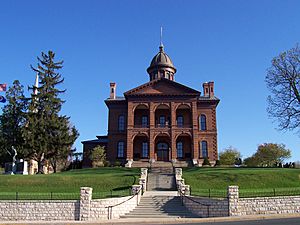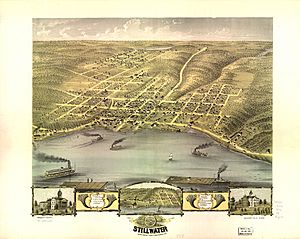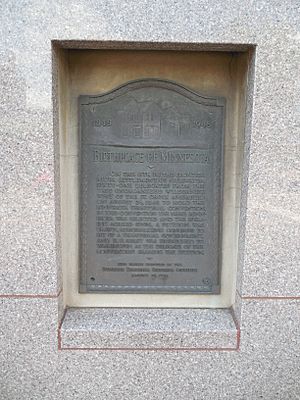Socrates Nelson facts for kids
Quick facts for kids
Socrates Nelson
|
|
|---|---|
| Member of the Minnesota Senate from the 1st district |
|
| In office December 7, 1859 – January 7, 1861 |
|
| Personal details | |
| Born | January 11, 1814 Conway, Massachusetts, U.S. |
| Died | May 6, 1867 (aged 53) Stillwater, Minnesota, U.S. |
| Cause of death | Tuberculosis |
| Political party | Democratic |
| Occupation | Merchant, politician, lumberman, real estate investor |
| Committees | Railroad and Railroad Bonds Special Committee State Prison Committee |
Socrates Nelson (born January 11, 1814 – died May 6, 1867) was an important American businessman and politician. He was a pioneer who helped build the community of Stillwater, Minnesota. Nelson served one term as a state senator for Minnesota from 1859 to 1861.
He owned a general store, worked in the lumber business, and invested in land. He was also involved with insurance and railroad companies. Nelson helped create the Minnesota Territory by joining a committee in 1848 that asked the U.S. Congress to form it. He also helped start the Minnesota Democratic Party.
Nelson was a county treasurer, a territorial auditor, and a county commissioner. Before becoming a senator, he was on the first board of regents for the University of Minnesota. As a senator, he worked on important issues for the state. After he passed away in 1867, the Nelson School in Stillwater was named after him. A plaque at the Washington County Historic Courthouse also honors him for selling the land where the courthouse was built.
Early Life and Family
Socrates Nelson was born in Conway, Massachusetts, on January 11, 1814. He lived in Greenfield and studied at Deerfield Academy. Later, he returned to his hometown to become a merchant, which means he bought and sold goods.
When he was 25, Nelson traveled to Illinois to look for opportunities. In 1840, he moved to St. Louis, Missouri, to sell goods and collect furs. There, he met Levi Churchill, who would become his business partner.
In 1844, Nelson traveled up the Mississippi River to the Wisconsin Territory. He opened a trading post near the Chippewa River. This post was called Nelson's Landing. On October 23, 1844, he married Betsey D. Bartlett in Hennepin, Illinois.
Later in 1844, Nelson took a steamboat further north to the new town of Stillwater. He opened the town's first general store, called Nelson's Warehouse. His wife, Betsey, joined him soon after. Nelson and Churchill traded goods using the Mississippi River. Nelson sent furs, and Churchill sent other merchandise.
Socrates and Betsey Nelson had twin daughters, Emma A. and Ella, on September 22, 1848. Sadly, Ella died when she was a baby on October 23, 1849.
Nelson was one of the first members of the Minnesota Historical Society, joining in 1849. He also became an early member of the Independent Order of Odd Fellows in 1849. This group became Minnesota Lodge No. 1 in Stillwater in 1852, and Nelson was a trustee.
Business Ventures
Nelson was very important in settling the St. Croix River valley. When he first arrived in Stillwater, he built a store and ran a business for eleven years. He soon realized that developing land would be more profitable than trading furs.
In 1845, Nelson and Churchill claimed large areas of land near the St. Croix River. They bought this land from the government in 1849. By 1847, Nelson was sending rafts of lumber downriver to St. Louis. In 1848, he and Churchill bought a large area of timberland together.
Nelson officially entered the lumber business on February 7, 1851. He became one of the founders of the St. Croix Boom Company. In 1852, Nelson and his partners, David B. Loomis and Daniel Mears, planned out what is now Bayport. There, they built a boarding house and a lumber mill called the S. Nelson Lumber Company. This steam-powered sawmill started operating in 1853, the same year Nelson left his general store business. The company closed in November 1858, and Nelson became the sole owner. He ran the mill sometimes over the next ten years and sold the property in 1868.

Nelson and Churchill also invested in land. In January 1857, they sold 40 acres of land to Robert F. Slaughter, a real estate salesman. This was just before a big financial crisis in 1857. When the crisis hit, land prices dropped a lot.
After the crisis, Levi Churchill died. In April 1867, Nelson and Churchill's wife, Elizabeth, offered to sell a block of land to the city of Stillwater for only $5. They hoped this would encourage development in the area. The city accepted, and the courthouse was built there, which helped the area grow. Nelson did not live to see this development.
Nelson was also involved in other businesses. In 1848, he helped start the Minnesota Mutual Fire Insurance Company. In 1853, he became a founder of the Louisiana and Minnesota Railroad Company, the St. Paul Fire and Marine Insurance Company, and the Minnesota Western Railroad Company. In 1854, Nelson and others started Stillwater's first newspaper, the St. Croix Union. This newspaper supported the Democratic Party and was printed weekly until 1857. On January 27, 1867, Nelson also became a founder of the Stillwater & St. Paul Railroad.
Political Career
In 1846, Nelson was elected treasurer for St. Croix County, which was part of the Wisconsin Territory. In 1847, he was elected treasurer and county commissioner again.
When Wisconsin became a state in 1848, some parts of eastern Minnesota, including Stillwater, were left without government representation. Nelson was one of seven people who met at the Stillwater convention on August 26, 1848. They gathered 61 signatures for a petition to Congress. This petition led to the creation of the Minnesota Territory in 1849.
On October 20, 1849, Nelson helped organize the Minnesota Democratic Party at a meeting in Saint Paul. That same year, he was elected treasurer for the new Washington County, Minnesota Territory.
From February 1851 to February 1859, Nelson served on the first board of regents for the University of Minnesota. He helped plan the necessary buildings for the university in 1856. He also served as the Minnesota Territorial Auditor from May 15, 1853, to January 17, 1854.
Nelson was a commissioner for Washington County in 1852, 1855, and 1856. In 1858, he helped organize Baytown Township near Stillwater. He also named Greenfield (later Grant Township) after his old home in Massachusetts.
In 1858, the Minnesota Democratic Party chose Nelson as a candidate for state senator. He was elected as a Democrat from the 1st district on October 12, 1858. He served in the Minnesota Senate from 1859 to 1861. During his time in the legislature, he was on committees for railroads and the state prison.
As part of the railroad committee, Nelson helped write a report in 1860. This report suggested removing a part of the Minnesota Constitution called the Loan Amendment. This amendment was meant to help build railroads faster by allowing the state to loan money to railroad companies. The amendment was removed later that year. On March 5, 1860, Nelson was one of five Democrats in the Minnesota Senate who voted for a bill that would have temporarily allowed bringing slaves into Minnesota. This bill did not pass.
In 1860, Nelson ran for state senator again but lost to Joel K. Reiner. Nelson continued to be involved in politics. He served on the Stillwater City Council from 1863 to 1865. In 1864, he was chosen as a delegate to the 1864 Democratic National Convention, where he supported George B. McClellan for president.
Later Life and Legacy
Nelson was president of the Old Settlers Association in 1859 and 1866. This group only accepted people who had lived in the territory before 1850. Nelson was one of its first members when it started in 1857. In 1866, he was also a trustee for the local society of Christian universalists.
In 1867, after being sick for several months, Nelson died from tuberculosis in Stillwater on May 6. He was 53 years old. Many businesses in the city closed that afternoon to honor him.
A plaque on the north side of the Washington County Historic Courthouse remembers the day Nelson and Churchill sold the land for its construction. As of 2020, this building was the oldest courthouse still standing in Minnesota. Nelson Street in Stillwater is also named after him. On September 28, 1885, the Nelson School, named in his honor, opened in Stillwater.




